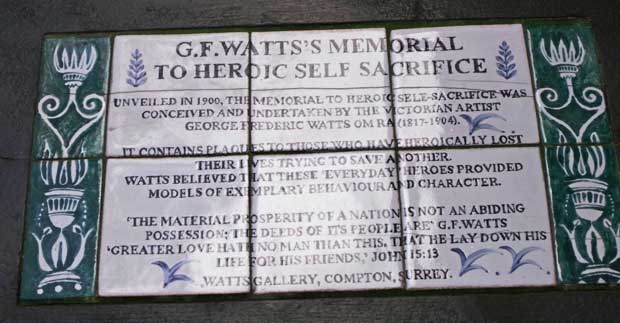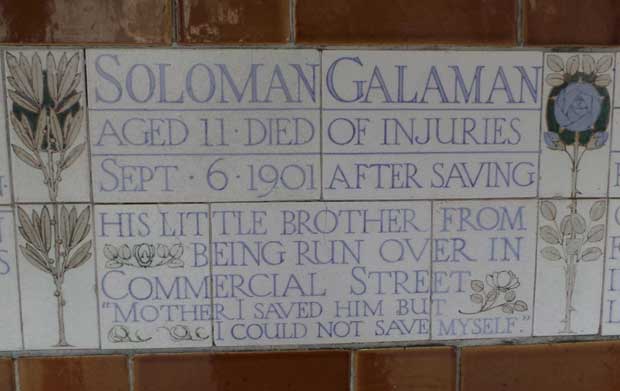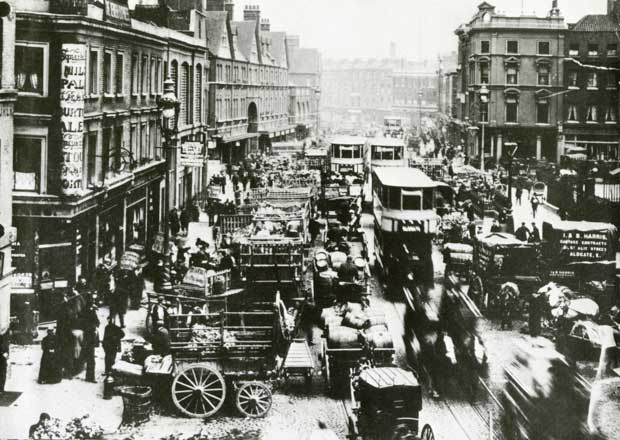One of the most poignant locations that I visit on any of my tours is the Watts Memorial to Heroic Self-Sacrifice, located in Postman’s Park, off Aldersgate Street, and which I visit on the Secret London walking tour.
The single wall of the memorial is adorned with 54 ceramic plaques that commemorate 62 men, women and children, who sacrificed their lives whilst trying to save the lives of others.
ENGLAND’S MICHELANGELO
The memorial was the inspired idea of the Victorian artist George Frederic Watts (1817 to 1904), whom many consider to have been England’s finest Victorian painter – whose artistic talent was such that he has been dubbed “England’s Michelangelo” and whose statuette nestles in a niche at the centre of the memorial that he created.

A SUGGESTION FOR THE JUBILEE
Watts had first become interested in remembering heroic deeds of self-sacrifice in the 1860’s, when newspapers began reporting them on a regular basis. However, it would be another 20 years before he began to formulate his plans when, in 1887, the year of Queen Victoria’s Golden Jubilee, he wrote a letter to The Times headlined “Another Jubilee Suggestion.” In that letter he stated that:-
“The character of a nation as a people of great deeds is one, it appears to me, that should not be lost sight of. It must surely be a matter of regret when names worthy to be remembered and stories stimulating and instructive are allowed to be forgotten.”
AN OFFER FROM ST BOTOLPH’S VICAR
Sadly, the powers that were, who were busily planning the jubilee celebrations, failed to share Watts’s vision and it would be another 11 years before, in 1898, Henry Gamble, the vicar of St Botolph’s Church invited Watts to site his monument in a new park that was being proposed alongside his church.
THE MEMORIAL FINALLY UNVEILED
That park would become Postman’s Park (so-called because of its proximity to the main Post Office buildings) and, on the 30th July 1900, the day that the new park opened, four ceramic tiles remembering acts of self-sacrifice by ordinary people were unveiled.

Watts died in 1904 and so never got to see his dream come to fruition. And, sadly, in many ways, it has never come to full fruition since, although there is room for over 100 plaques, only 54 are displayed.
A SURPRISING NUMBER OF CHILDREN
A surprising aspect of those remembered is just how many of them were very young children.
One of these children died whilst performing an act of heroism on Commercial Street, which we cross every night on the Jack the Ripper tour.
THE SOLOMAN GALAMAN TRAGEDY
His name was, according to the plaque:
“Soloman Galaman, aged 11, Died of injuries Sept 6 1901 after saving his little brother from being run over in Commercial Street.”
The plaque also reports his poignant last words as “Mother I save him but could not save myself.”

HOW HE DIED
According to the report on the Coroners inquest in the East London Advertiser, Soloman, who was the “…son of a journeyman tailor residing at 73 Cable Street, St George’s East,” had left home on Tuesday 3rd September (not the 6th as reported on the plaque) to visit his grandmother with his four-year-old brother, Samuel, when the accident occurred.
CROSSING COMMERCIAL STREET
Witnesses reported seeing the two boys trying to cross Commercial Street when the younger of the two slipped and fell into the path of an approaching cart. Seeing that his brother was unable to get out of the cart’s way, Soloman sprang into action and managed to push him out of the way.

Sadly, he found hmself unable to move quickly enough to avoid the approaching cart, and he was run down and then dragged along beneath the wheels receiving, according to the horrified onlookers, “terrible injuries.”
HIS POIGNANT FINAL WORDS TO HIS MOTHER
Witnesses rushed the badly injured boy to the nearby London Hospital, whilst a police constable took Samuel home and informed their mother, Elizabeth, that her older son had been involved in an accident.
She was taken to the hospital but, on arrival, she found that little could be done to save her son’s life. As she leaned over his prostrate form, he was said to have looked up at her and whispered “Mother I am dying. Have they brought my little brother home? I saved him but I could not save myself.” He then, reportedly, kissed her, sank back onto the bed, and died a short time later.
WELL WORTH A VISIT
Soloman Galaman’s is just one of 62 names commemorated on this wall in Postman’s Park and, if you’ve never visited this poignant memorial, you can visit it on our Secret London Tour.
However, if you would prefer to visit the park and the memorial on your own, the closest underground Station is St Paul’s. Come out of the Station onto St Martin Le Grand and you’ll find it about 3 minutes walk along on the left side, just opposite the Lord Raglan Pub.
It really is a peaceful and poignant spot and one that should be on the itineraries of all Londoners and visitors alike.
